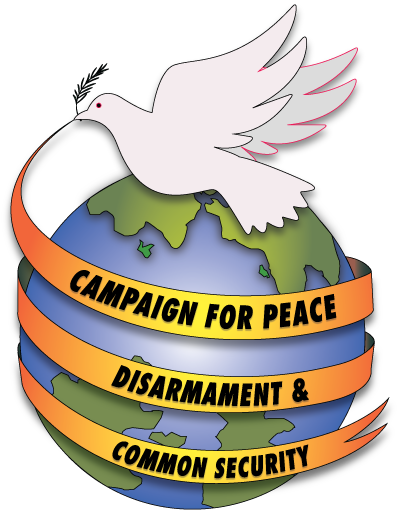No Fire, No Fury: Common Security Diplomacy to Resolve US-North Korean Crisis
President Trump’s off the cuff and extremely dangerous and outrageous threat to devastate North Korea with “fire and fury… unlike the world has ever seen” is bringing us to the brink of the unthinkable. There is no military solution to the dangers posed by North Korea’s nuclear weapons program. We need to do all that we can to bring reason to bear with Common Security diplomacy that can bring these two nuclear powers back from the brink and to establish the basis for a nuclear-free Korean Peninsula and Northeast Asia.

At a time when even his Secretary of State was raising the possibility of conditional U.S.-DPRK negotiations, with ignorance and brutal arrogance President Trump ratcheted up the confrontation in ways that make it more difficult for Kim Jung-Un to compromise without losing face. Regardless of whether Trump’s threat was simply braggadocio in the tradition of Kim Jun-Un or an attempt to divert attention in the U.S. from his cratering poll numbers and the possibility of his being indicted or impeached, he is sleepwalking the world toward catastrophe. With China indicating that it would intervene on North Korea’s behalf in Trump launches a regime change war, we face a situation with dangerous parallels to the period leading to the Guns of August in 1914.
“Regardless of whether Trump’s threat was simply braggadocio in the tradition of Kim Jun-Un or an attempt to divert attention in the U.S. from his cratering poll numbers and the possibility of his being indicted or impeached, he is sleepwalking the world toward catastrophe.”
Except this time, the guns could be either side’s nuclear armed missiles.
Unlike 1914, the terms for diplomatic solution of this crisis have already been identified and enjoy considerable international support, including from elite sectors and grassroots activists across the United States: As William Perry, Richard Hass, Bruce Cummings and others have urged, the U.S. must commit to direct negotiations with the North Korean government. The goal would be an agreement whereby the Kim regime freezes its missile and nuclear tests; the U.S., South Korea and Japan halt their provocative joint military exercises, and all sides would commit to ending the Korean War with negotiation of a peace agreement.
In crisis, there is opportunity.
The U.S.-North Korean confrontation has been described as a “Cuban missile crisis in slow motion.” On one side is North Korea’s “relentless” and unacceptable drive to build its nuclear arsenal and its more recent threat to devastate Guam, whose innocent Chamorro population never invited the U.S. military to occupy their nation with massive military bases. On the other side are the mixed signals emanating from President Trump and his administration which have exacerbated the crisis. At various times, President Trump has vowed that North Korea will never achieve the capability to attack the United States, although this has now apparently been achieved. He and his Secretary of States have expressed a willingness to meet and negotiate with Kim Jung-un, while simultaneously threating to take severe actions against North Korea, piling on sanctions and threatening “regime change.”
As Bruce Cummings, the leading U.S. scholar of Korean history teaches, the Kim regime is ruthless and brutal, but it is not reckless. Nor is it suicidal. Instead, its priorities and nuclear arsenal are designed to preserve the “divine” Kim Dynasty and North Korean sovereignty, with development of the North Korean economy an important but secondary priority.
Consistent with North Korean, Chinese and Russian proposals—under the cover of “creative diplomacy”—the Common Security approach seeks a near-term freeze in North Korea’s nuclear and missile arsenals in exchange for halting threatening U.S.-South Korean military exercises and finally ending the Koran War by replacing the Armistice Agreement with a Peace Agreement. Negotiations for denuclearization of the Korean Peninsula could then be pursued on the basis of improved relations and increased trust.
With Moon Jae-in’s election, his commitment to negotiations, and his commitment to framing a negotiation plan for the complete denuclearization” of the Korean peninsula, Trump—if he lasts in office—may have no alternative but to pursue the diplomatic option.
In 1962, the U.S. and the Soviet Union went “eyeball to eyeball” in their nuclear confrontation, with figures in the Kennedy Administration stating they believe the chances that the U.S. would initiate a nuclear exchange at between one-third and one-half. We now know that such an exchange would have brought on nuclear winter, ending all life as we know it. We are here because a face saving solution was found with public and secret compromises. Before Donald Trump and Kim Jung-Un paint themselves into nuclear corners from which they and we cannot escape, in every way that we can imagine we need to urge them and those around them to step back from the brink. The challenge is to unleash the popular forces in the United States and the necessary diplomatic pressure from European and Asian nations.
The time to act is now.
Original Article: https://www.commondreams.org/views/2017/08/11/no-fire-no-fury-common-security-diplomacy-resolve-us-north-korean-crisis

